Newsletter
Eat your way across L.A.
Get our weekly Tasting Notes newsletter for reviews, news and more.
You may occasionally receive promotional content from the Los Angeles Times.
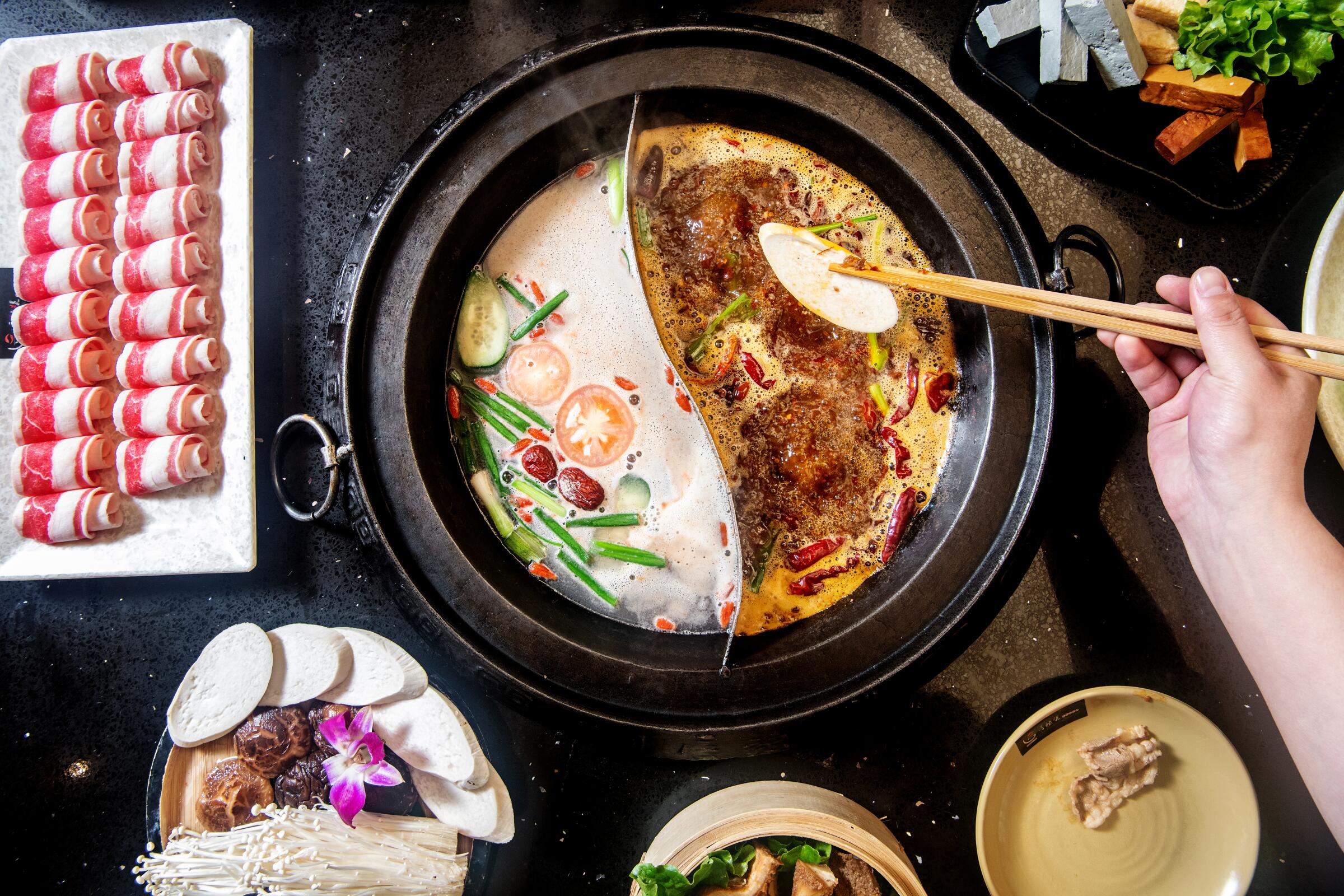
In October, restaurateur Bill Chait, who has fingerprints on some of the most acclaimed establishments in Los Angeles, took a flight to China’s Sichuan province, where he delighted in whole roasted rabbit sold on the street and bullfrogs dropped into a burbling hot pot via a bamboo chute.
He and the owners of Chengdu Taste strolled through the famed Wide and Narrow Alleys of Chengdu before an obligatory stop at Xiao Long Fan Da Jiang, an upscale outpost of Xiao Long Kan, one of the most popular hot pot destinations in the world — and one of the fastest-growing restaurant chains in China. Chait marveled at the design, the flowing water, the theater show at the center of the restaurant, the temple-like quality of its architecture. In a city where there could be as many as 20 hot pot joints on a single block, the pageantry of Xiao Long Kan made it feel essential.
Of course, if he’d waited a month, he could have experienced it much, much closer to home.
Xiao Long Kan is just one of many hot pot empires making its way to L.A., so you’d be forgiven for not noticing its sound or fury. Under the cover of Valley Boulevard’s 20-mile curtain, the San Gabriel Valley can feel like a shadowland operating on a completely different set of rules. But the Sichuan hot pot demand in L.A. (and other Western megalopolises) has taken on a sense of Manifest Destiny.
The San Gabriel Valley is in the midst of a sea change, and the ever-growing presence of Sichuan- and Chongqing-style hot pot restaurants populating the region is the clearest sign.
Outside Xiao Long Kan’s first U.S. outpost, there is a line that forms daily, just as the sky darkens to slate blue. The Alhambra restaurant opens at 5 p.m.; by 4:45 there will be at least 10 parties on the waitlist.
By 5:10, a menagerie of Chinese expats fills the space outside: middle-aged men dressed head to toe in the inordinately popular streetwear brand Supreme; a woman wearing a new pair of Kanye West’s Yeezy Boost 350 like house slippers, her heels crushing their hind walls (the shoes retail for $200 but often sell for at least twice that on the secondary market); a small Chinese film crew shooting what appears to be a double date between two Chinese women adorned in cocktail dresses and two chiseled Westerners in blazers and gold chains. Maybe it’s a scene for a reality TV show or a sponsored tourism ad destined for Weibo — who’s to say?
The main attraction of the night is a slice of home, or three. In parlance, it is called butter: slabs of solid-state beef tallow, dyed safety orange from an infusion of hot and numbing spices meant to warm the body while simultaneously lifting it off this plane of existence.
The rafts of spiced fat float in a fortified stock in a pot divided into multiple compartments. Those lurid, slow-dissolving tablets might be visually disconcerting in any other context, but here they are a mark of quality. It’s an assurance of flavor, a particular fix for a particular addiction.
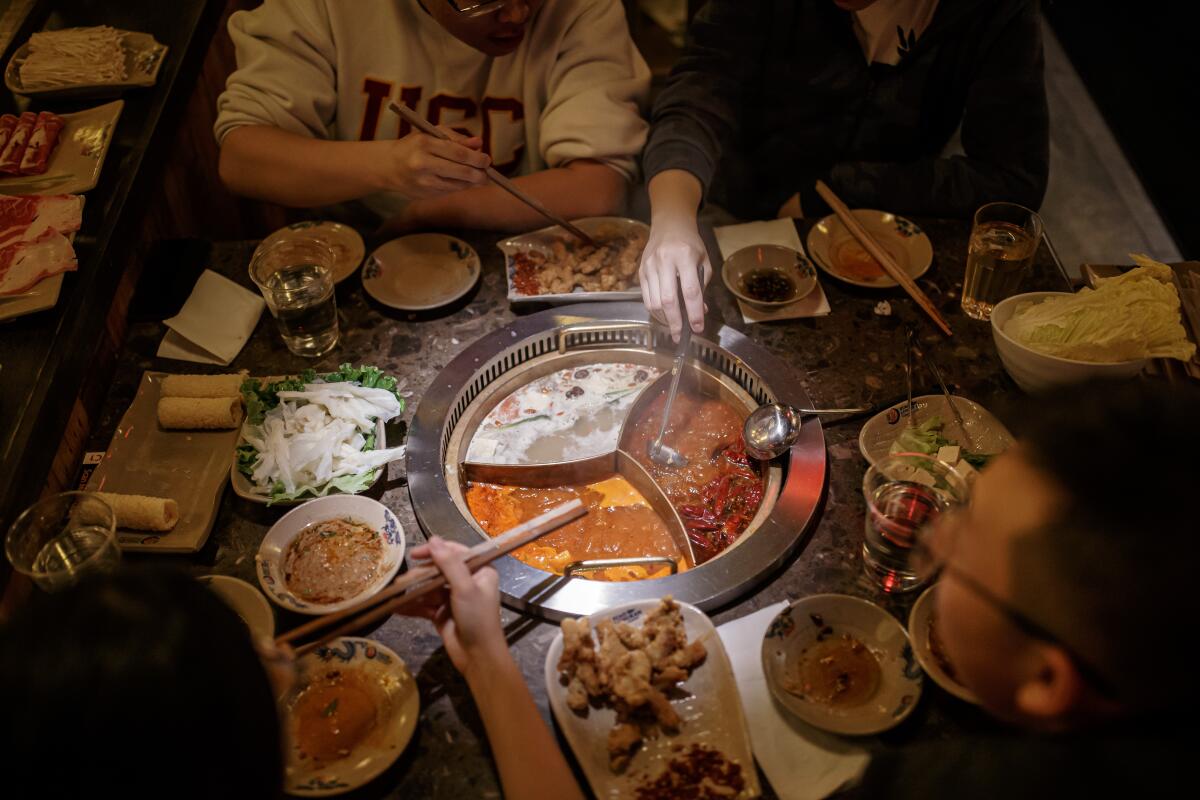
Sichuan cuisine can, and often does, create an out-of-body experience, one that specifically numbs the very parts of the body that derive pleasure from eating, creating a sort of pain that gives way to a perverse enjoyment. And fat is the ultimate conduit. That maximalist union of fat and spice is the soul of Sichuan hot pot, the most popular dining experience in China today — which numerically speaking makes it the most popular dining experience in the world.
The sheer magnitude of China’s potential for consumption can be difficult to grasp. Forecasts at the beginning of 2019 saw China overtaking the U.S. as the world’s largest consumer market, and there is little reason to believe it hasn’t. China’s surging middle class, which has expanded by hundreds of millions since the turn of the century, has exponentially increased its spending power.
One clear benefactor has been the nation’s hot pot industry, which is projected to surpass 700 billion yuan (or roughly $100 billion) in revenue by 2022, according to the market research consultancy firm Frost & Sullivan.
HaiDiLao, by far the most popular hot pot franchise in China, is worth more than Chipotle. Valued at roughly $21 billion as of 2019, it opened its first U.S. outpost in Arcadia in 2014, sensing the potential of establishing a base in the San Gabriel Valley, which in the last several decades has fortified its reputation as a haven for mainlanders. Jonathan Gold, in his 2014 review of the chain, noted an emergent hot pot trend in the SGV that predated China’s biggest chain entering the fray; since then, it’s bordered on a pandemic.
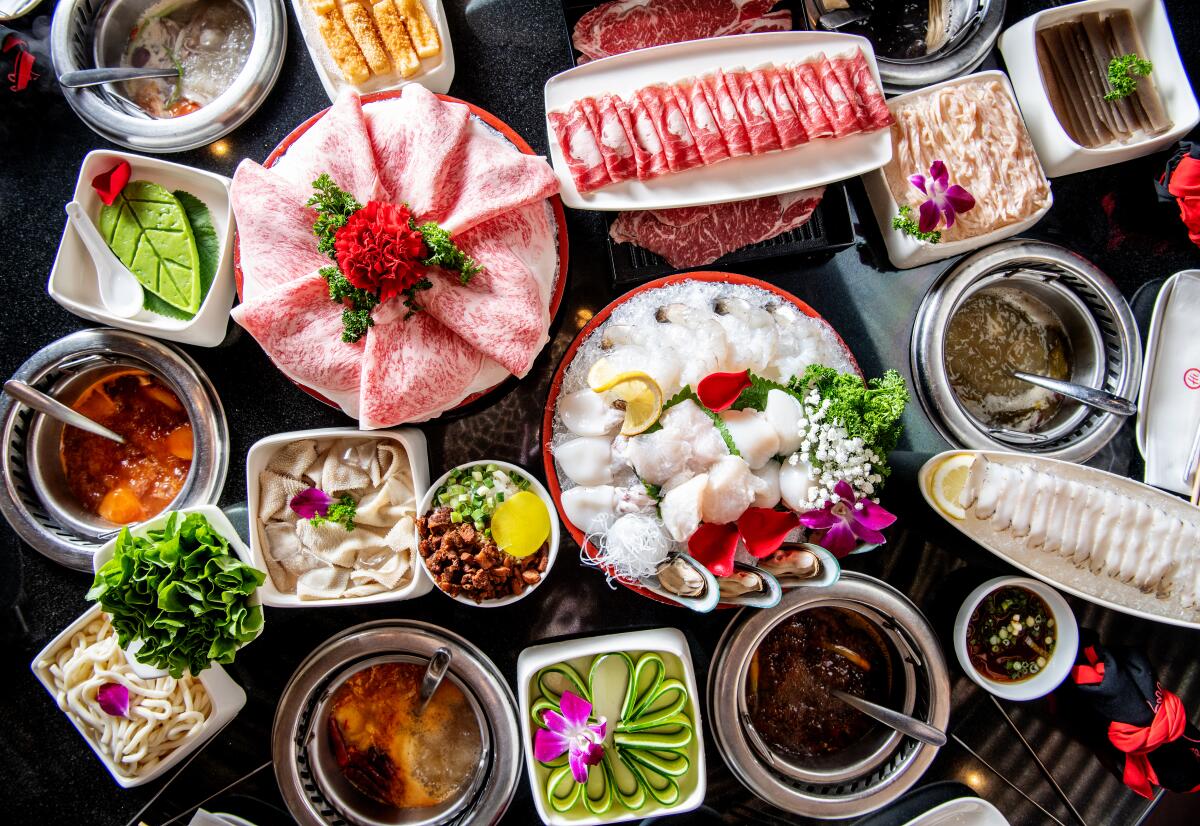
In an August review of Da Long Yi, a popular Sichuan hot pot chain from Chengdu that recently opened in Manhattan, New York Times food critic Pete Wells estimated there were two dozen to three dozen hot pot restaurants in New York City; according to Yelp research for the Los Angeles Times, that’s roughly the same number that have opened in the San Gabriel Valley’s Asian communities in the last two years alone.
The appeal of Sichuan hot pot is manifold. There is an overabundance of flavor, yes, but there is also a sense of power. To eat hot pot is to be granted a heightened level of agency for however long one sits at the table: Diners decide how numb they want to feel, as well as what goes into the pot, where and for how long.
Like Korean barbecue, which also has had its day at the vanguard of L.A. food trends, hot pot is an experience best shared among friends or family. Everyone plays a role in shaping the meal: The soup matures over time, its flavor fortified with every morsel that plunges into its waters. The community-building that happens around a hot pot table is unique. Chasing meat sweats at a Korean restaurant is one thing; bonding over the searing pain of the myriad spices is another. That’s what makes it a perfect food for our modernity. Sichuan hot pot is a great way to celebrate, but it’s also a perfect way to commiserate.
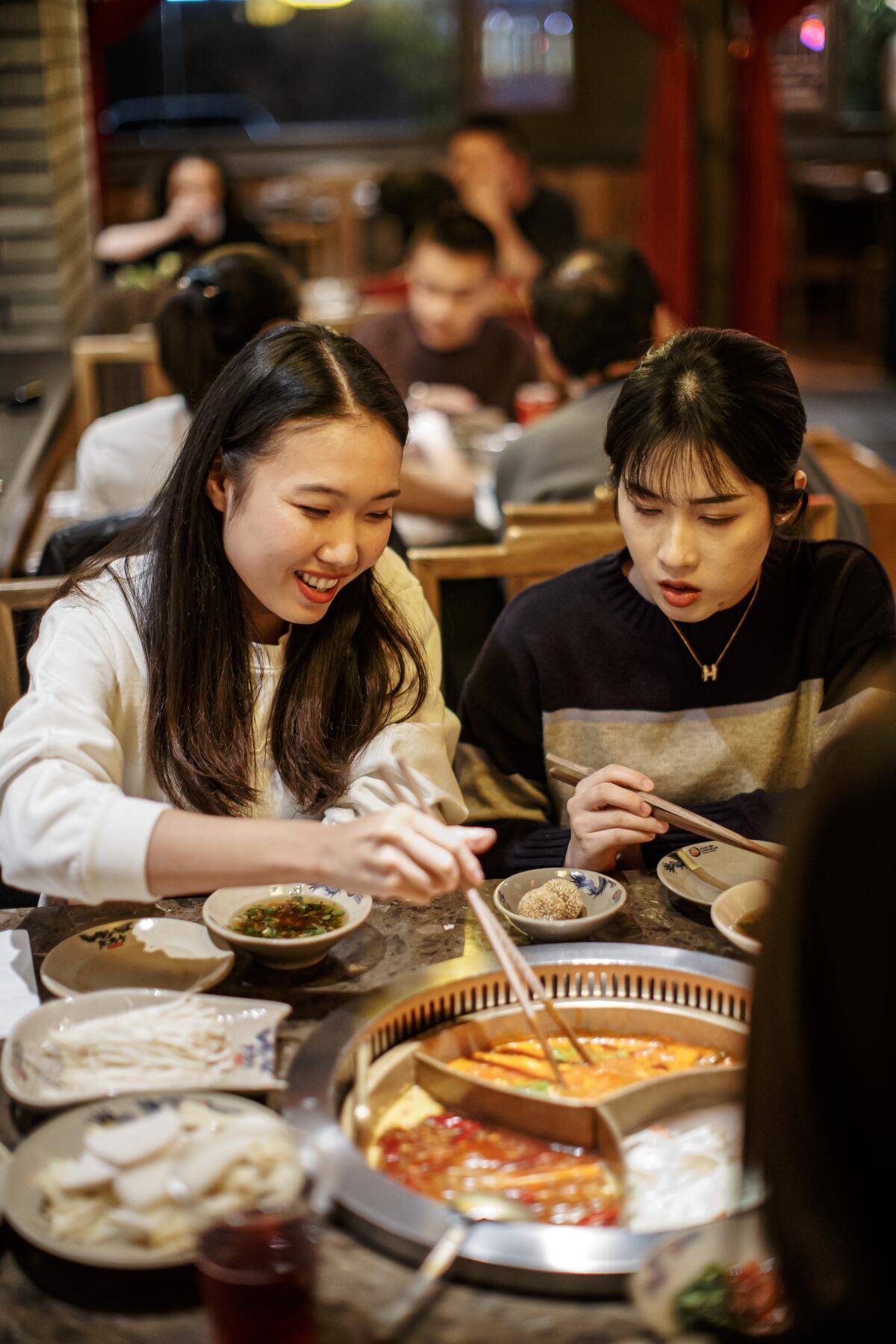
“I personally think there are two reasons” for the demand, said Sean Xie, a partner at Chengdu Taste and one of the restaurateurs who helped bring Xiao Long Kan stateside. “Hot pot itself has become very popular in China the last few years, along with Sichuan cuisine. So even in China, we’re saying Sichuan cuisine is taking over the world because it’s gaining a lot of popularity inside of China.
“The other reason is, I think, starting 2013 or 2012, we were seeing a huge transformation of the Chinese cuisine in the U.S.”
The transformation came with a dramatic shift in the demographics and solvency of the Chinese immigrants; they have benefited from China’s booming decade of economic development, arriving with specialized skills and more capital than previous waves of Chinese immigrants. Those generations, largely from the coastal provinces of Fujian and Guangdong, often were looking to make a living in a new land by adapting taste memories of home with what resources they had — and laying the foundation for the San Gabriel Valley to become one of the greatest places on Earth to eat Chinese food.
Times columnist Lucas Kwan Peterson wrote last year about the decline in Cantonese banquet-style restaurants, which have become outmoded in favor of Sichuan and hot pot restaurants; according to Yelp, there have been more than 125 hot pot and Sichuan restaurant openings in the San Gabriel Valley since 2015.
The change is a reflection of the power and palate of the new wave: Sichuan is the cuisine of preference among the upwardly mobile and their children, and thanks to the U.S.’ EB-5 immigrant investor program (which grants a business visa and citizenship opportunities to those able to invest at least $500,000 in a business and create at least 10 jobs), it’s easy and beneficial to superimpose pieces of modern Chinese life wholesale for those with the resources.
Among the most upwardly mobile members of contemporary Chinese society, “China has gotten to a level now where everyone is sending their kids to America to go to school,” said Jenny Gao, the proprietor of Fly by Jing, a line of specialized Sichuan sauces and seasoning mixes. “It’s just natural that there’s going to be more Chinese restaurants from the mainland, and of those, the highest percentage will be Sichuan.”
Chait, the restaurateur behind Bestia and République, is helping Chengdu Taste expand its restaurant concepts to the Westside of L.A. During his trip to China last fall, he visited the Xiao Long Kan production facility in Meishan, a city one hour south of Chengdu, and found robots creating the soup base at an unfathomable scale.
“The facility, this is not a small undertaking,” he said. “They’ve really gone after the systematization of the basic flavor. And they ship that everywhere. That product is really the key to the whole dish. Without it, there is no hot pot.”
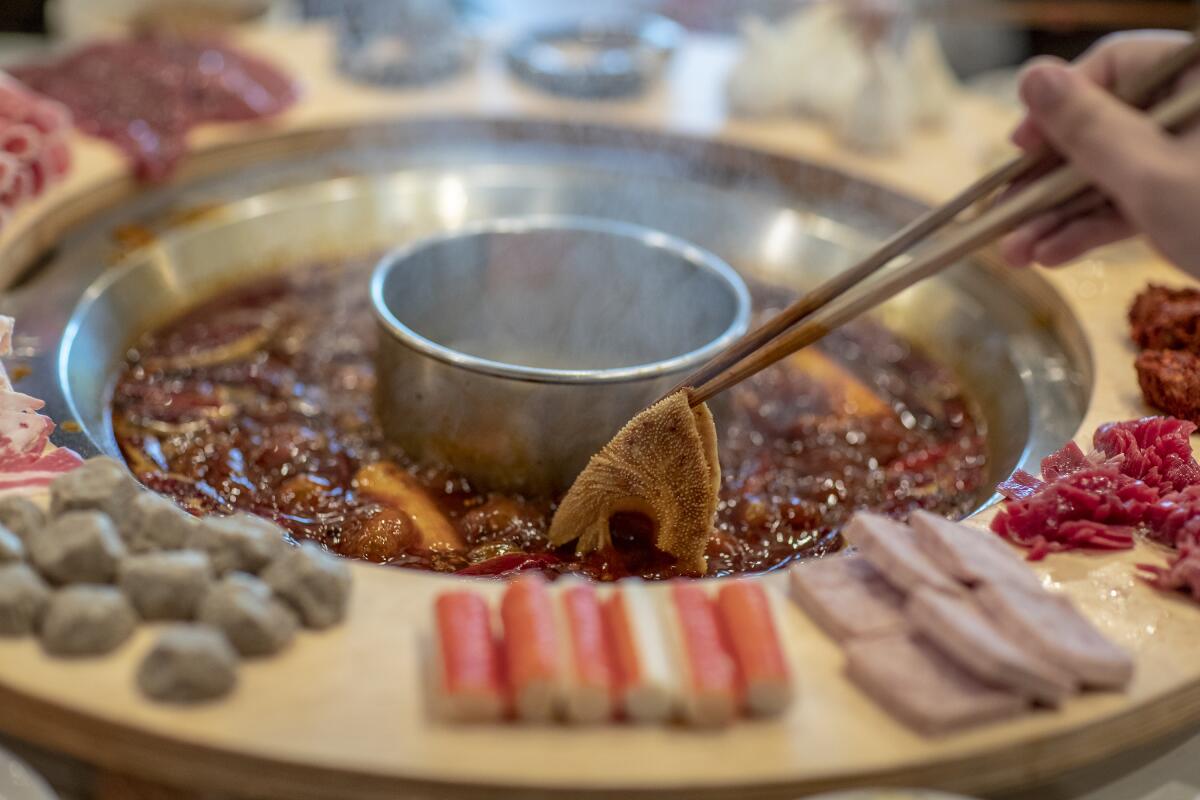
These days, operating a hot pot restaurant just requires capital and the willingness to piece together a few building blocks.
“You could open up a restaurant in Sichuan and without a chef,” Gao said. “There are thousands of factories in Chengdu that make hot pot soup bases. It all comes to restaurants in plastic bags. It is rare to find a restaurant that makes their own anything from scratch.”
And if you can do it in Sichuan, you can do it anywhere.
A new Los Angeles Times Food series devoted to the best fried chicken in Los Angeles, hosted by senior food writer Jenn Harris.
Last year, three major Sichuan hot pot chains from the mainland — Xiao Long Kan, Chun La Hao and Da Long Yi — opened outposts in L.A. Xiao Long Kan, based in Chengdu, pays proper reverence to the region with architecture that appears to be a tribute to antiquity: ornate wall panels, glowing lanterns and unvarnished wooden tabletops. Chun La Hao, despite offering a taste of Chongqing (a sprawling metropolis in southwest China where there are purportedly more than 50,000 hot pot restaurants), is a chain from Beijing, and it is clear that its vibe hews closer to caricature, with fake bamboo columns all over the restaurant. (It’s following the lead of Chuan’s, a Sichuan restaurant in Temple City that opened in 2014, the first major mainland transplant to champion that aesthetic in the San Gabriel Valley.)
Each restaurant offers a lurid experience. Da Long Yi’s housemade shrimp paste lands at the table as a drab mush pile in a shallow dish, but there is whimsy in forming little morsels by spoon and watching the mixture activate in the bubbling broth, where it becomes buoyant and takes on the rouge of the inescapable crimson oil. Quickly scalding the slippery ribbons of duck intestine in the tallowed broth at Xiao Long Kan approaches what I’d imagine to be the Sichuan ideal, even if it’s the comically incendiary heat levels of Chun La Hao’s soup base that I find myself longing for most often.
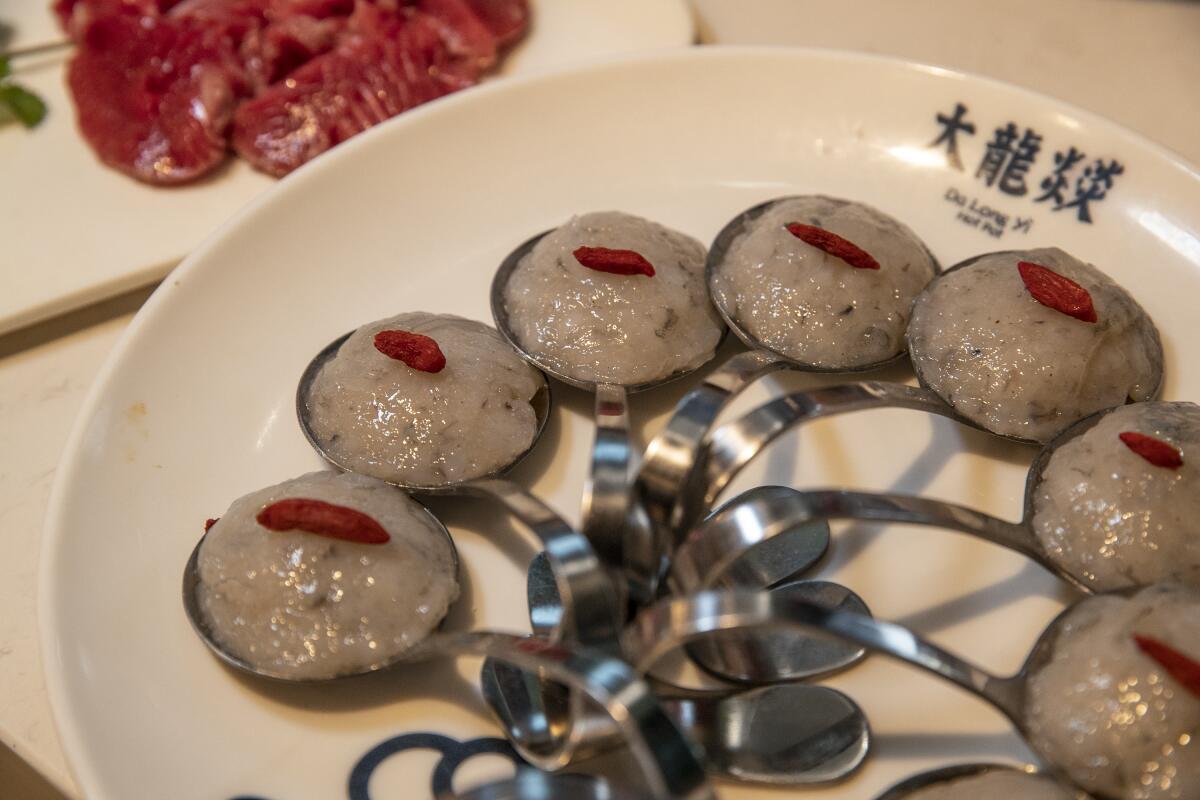
And yet, these delights arrive with a hint of melancholy. They are, indeed, fixtures of a new era in the San Gabriel Valley, my lifelong home. At Chun La Hao, with tears starting to form in my eyes from the unhealthy cocktail of beef tallow, gluttony, Sichuan peppercorns and masochism, I was reminded that, exactly a decade earlier, in the same building and address, I’d cried with friends over our looming post-high-school uncertainty with an Applebee’s quesadilla burger in hand. I felt the newest layer of the San Gabriel Valley’s palimpsest being written, and I was making an inscription.
It’s all an exercise in perspective. Chengdu Taste, one of the most important L.A. restaurants of the last decade, opened in 2013, and now has locations in Las Vegas, Honolulu and Houston, with plans to expand into Seattle and other markets — a massive success by U.S. restaurant industry standards.
Xiao Long Kan, which is having its stateside expansion managed by the Chengdu Taste group, opened its first location in 2014 and has more than 800 locations in China. “To open up and remodel 800 stores in four years — you can’t even imagine that in the U.S.,” Xie said.
Over the decades, the restaurants that served as strongholds for the SGV’s vibrant Asian community all held a similar ethos: As painstakingly traditional as the cuisine being served was, there was still a tacit sense of compromise, of reanimating a memory or experience but still not being all the way there, of letting the unique benefits and challenges of American life fill in the rest of the story on the table. Dropping an uncompromised scene straight from the bustling city of Chengdu into any number of American metropolises delivers a different narrative: The community is engaging in a new paradigm, one much, much larger in scope.
Eat your way across L.A.
Get our weekly Tasting Notes newsletter for reviews, news and more.
You may occasionally receive promotional content from the Los Angeles Times.